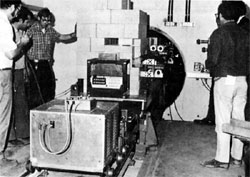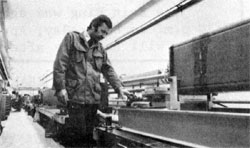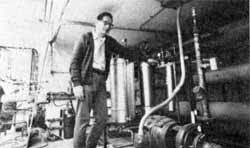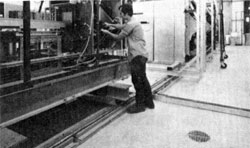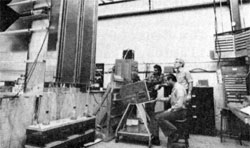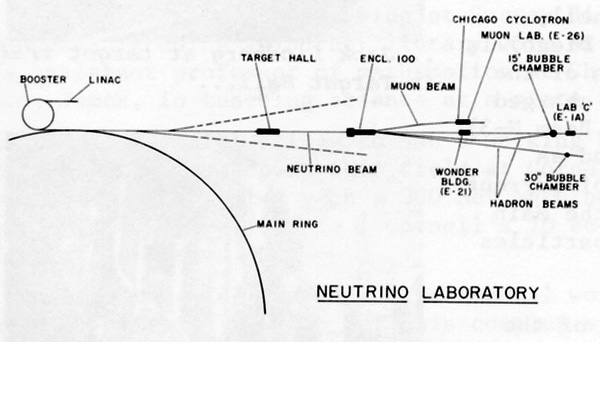Neutrino Lab Readies for Beam
The pursuit of the elusive neutrino particle was one of the liveliest races on the NAL program. Capable of going through the entire earth without interacting with anything, the weightless neutrino can be observed only when a great number are present. The high energy and intensity of the NAL beam produces an abundance of neutrinos of high enough energy to permit study of the so-called "weak interactions."
The NAL Neutrino Laboratory provided the facilities for this study. In the Target Hall of this Laboratory, the proton beam from the Main Ring smashed into a miniscule target - a tiny rod of aluminum measuring .1 inch by .2 inch - and this collision broke up the nuclei of the target. The debris of this crash resulted in formation of pi mesons and k mesons, with a lifetime of 1/100 millionth of a second. Their death, or decay, in turn produces the neutrino.
The Neutrino Laboratory runs along Road A-l, one mile in length. In this vast expanse of facilities, staff members have been working diligently for the past two years on the construction of four beam lines and the conventional facilities that carry neutrinos and muons (another particle produced as a by-product of neutrino production) to experimental halls.
A 6 ft. diameter target tube, buried under 30 feet of earth shielding, is the main feature of the Target Hall. The neutrino targetting system consists of a 200-ft. long arrangement of magnets and detectors, in the heart of which is the tiny aluminum rod that is the actual target. The entire array is mounted on a narrow-gauge railroad train on a track built into the tube so that the target may be inserted into the tube during operation or may be withdrawn into the tunnel of the Target Hall to be worked on.
Next in the Neutrino Laboratory line is a 1300-ft. long, 3 ft. diameter vacuum pipe. In this pipe the neutrinos are born, in the decay of pi and k mesons following the collision of the beam on the target.
From here, various magnets, power supplies, control stations and particle detectors located in twenty small buildings along the neutrino line guide the newborn particles to the appropriate experimental area. Two neutrino experiments. Experiment 21, an NAL-Caltech group, in the Wonder Building, and Experiment 1A (a collaboration of Harvard, Penn. and Wisconsin) in Building C of the Bubble Chamber area, presently set up and ready to take data. One muon experiment. Experiment 26 (involving Cornell, Michigan State, and University of California, San Diego) is ready to register beam. Running the entire length of the Neutrino Laboratory are two lines that will carry charged particles to the 30-inch Bubble Chamber (known as Beam N-3) and to the future 15 ft. Bubble Chamber (designated as Beam N-5). The N-3 beam line was the focal point of 1972 efforts, getting it ready to accept protons from the Main Ring, target them, and deliver sorted and tagged particles to the appropriate experiment.
Physicist Timothy Toohig, has directed much of the development of the Neutrino Laboratory. His group merged with the Bubble Chamber group in April 1972 and the combined section is headed by William Fowler. Dr. Toohig explained for THE VILLAGE CRIER the organization that was responsible for the Neutrino Laboratory:
"Preparation of the area has been an ecumenical effort involving many people and groups," Dr. Toohig reports. "Staff physicists are Joe Lach, Frank Nezrick, Ray Stefanski, Yong Kang. Stan Pruss, Taiji Yamanouchi, with collaboration of Al Maschke, Les Oleksiuk, and with Phil Livdahl in the Godfather role. Jim San ford developed key concepts for the area.
"The core group of the installation effort was Frank Krzich, Reid Riliel, Leon Beverly, Max Palmer, Waynei Nestander, Russ Winje, Jan Wildenradt, Don Carpenter, John McCarthy, Gene Woods, Jim Walker, Jack Lindberg, John Simon, and Frank Mallie," Dr. Toohig explained.
"Essential to the whole effort were the Controls Group under Bob Daniels, and the Alignment Group under Bill Testin. Tom Pawlak was the DUSAF representative."
He continued, "Miguel Awschalom and his stalwart staff kept us always honest radiation-wise, and, finally, Ginny Linguist has kept typing typed and the coffee warm."



